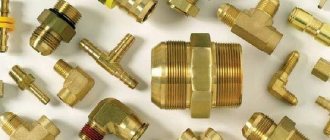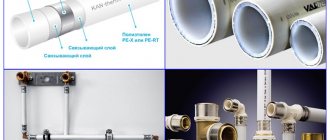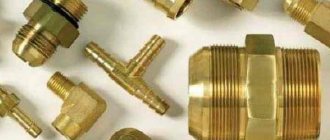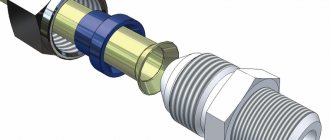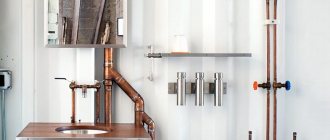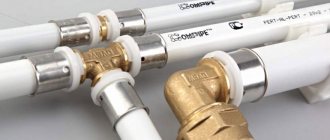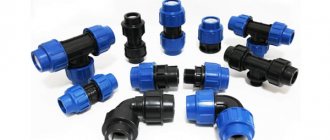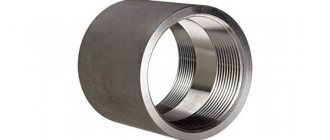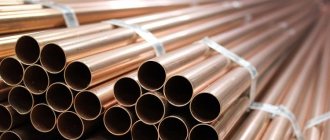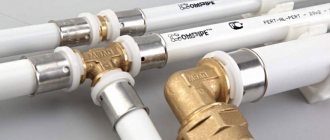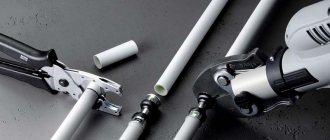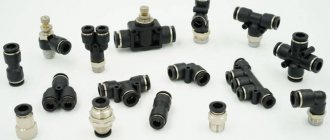Installation of a water supply system is an important and complex stage of repair work. Due to the hardness of tap water and pressure drops in the system, residents of apartments and private houses have to regularly change or repair water supply and sewerage elements. Why don't you consider installing more reliable and high-quality products? Copper water pipes can be used for decades. Especially if each water pipe was correctly manufactured and installed by a professional craftsman.
Characteristics
Copper fittings are resistant to heavy loads and are not susceptible to exposure to external factors for a long time. In addition, the long service life is not reduced. The advantages of such structures can be seen in their technical characteristics:
- Firstly, it has good temperature stability. Copper products are not afraid of very low temperatures from minus 200 °C and very high temperatures up to plus 250 °C.
- Secondly, with exposure to low temperatures, the strength of the copper material only increases. What other materials cannot boast of.
- Thirdly, the resistance of copper fittings and pipes to corrosive processes, exposure to ultraviolet rays and destruction by many negative chemical compounds.
- Installation of copper pipelines is not difficult due to the soft properties of the metal and plasticity (when compared with other materials).
- Since copper pipes and fittings are not as rough as, for example, plastic ones, the smooth inner surface will allow you not to worry about the formation of various deposits.
- Copper properties protect water from bacteria.
- Well, as a conclusion, it is worth saying that copper products are attractive in appearance. Therefore, you can not close the pipes from view, but choose an open gasket where they will look like design elements.
As a disadvantage, we can mention the considerable cost of copper fittings and pipes, some difficulty in installation due to incompatibility with pipelines made of other metals. If copper products are installed, for example, with steel products, an electrolyte reaction may occur. In this case, corrosion cannot be avoided. But, of course, you can purchase special adapters.
You can read about the types of copper pipes for heating on this page.
Where are copper pipes used?
Fittings and pipes made of high-quality copper are not inferior in technical qualities to components for pipelines made from other popular materials. Unlike iron-based alloys, copper does not rust at all. In addition, it is not afraid of ultraviolet radiation, extremely low and high temperatures, whereas polymer compounds are equally destructive to sunlight, frost and extreme heat. Copper pipes weigh little, are easy to transport, store and install.
All these positive qualities allow copper pipe products to remain popular as components for installation of systems:
- hot and cold water supply,
- air conditioning,
- gas distribution,
- heating.
Methods for connecting copper pipes with fittings
You can connect copper pipes using fittings using the following methods:
- soldering method;
- crimping method;
- using compression and threaded detachable connections or using push fittings.
To select any of the fittings, you should take note of the following parameters:
- length of the smooth end;
- internal and external diameters;
- the depth of the socket (fittings have it for any connection, and calibrating the socket makes installation easier);
- distance between pipe and fitting.
Installation features
Installation of copper pipes can be carried out in two ways: by soldering and by threaded connections (using crimp rings). Before carrying out any installation work, preliminary measures should be taken.
It is important to sketch out a detailed piping plan first. After this, you will be able to calculate the exact quantity of consumables (fittings, messages), and select all the necessary tools.
The soldering scheme for copper pipes is not complicated
The choice of tool depends on how the installation will be carried out:
- Soldering of copper products can be high and low temperature. The low-temperature process occurs using soft solder (low-melting materials such as tin or lead). Low temperature soldering is performed at 450 °C. Connecting elements are standard fittings or system parts that have already been flanged and expanded. Before starting the installation process, the parts of the water supply system that are to be connected are carefully cleaned with ordinary solder. This will improve subsequent grip. Using a torch, the copper product and fitting are heated. The solder automatically heats up and fills all the voids between the pipe and the fitting. Soldering is considered the most popular, as it guarantees complete tightness of the created connection and preserves the integrity of communications;
- When implementing the second method, a part of the system is sequentially pressed in using a special fitting. This way you can fasten the products together even in the most difficult to reach places.
Types of copper pipes for water supply and heating
Copper is a very soft metal, so soldering must be carried out with extreme caution!
Copper solder fittings
A copper fitting for soldering has its own nuances. For example, it is characterized by low cost when compared to other connection methods. To some extent, this is due to the fact that fittings for soldering copper pipes are structurally simple and only one type of copper is used in production for all sizes.
Types of Copper Solder Fittings
The process of soldering copper fittings can be done using hot or cold methods:
- When soldering at high temperatures, shortened shaped fittings are used. They are not intended for gas systems, since the weld strip is not very thick, but at the same time, such fittings show excellent performance in creating heating communications and water supply lines.
- When soldering at low temperatures, special fittings will be required. The difference in their appearance is the presence of a special groove, which is made around the circumference at the junction. Solder is placed into the groove at the time of manufacture, which greatly simplifies installation. During installation, this fitting is attached to a pipe where the edge is coated with flux. After all, you just need to warm up the connecting section using a burner device. This way you will get a reliable connection.
Comparison with pipes made from other materials
In order to conduct a comparative description of all types of communications that are used today for water supply system equipment, it is necessary to highlight the basic requirements for products:
- Duration of operation. Copper pipes are the undisputed leader when it comes to service life. They can be used for 50-70 years. For steel this period is 20 years. Polypropylene systems are also durable (last about 50 years), but all temperature requirements must be strictly met;
- Difficult to install. Construction practice shows that installing a system made of non-ferrous metal will require special equipment. Only a professional craftsman can perform high-quality soldering. If we talk about products made of plastic or steel, then for installation you only need to stock up on a welding machine and a set of standard tools (drill, screwdrivers, pliers);
- Terms of Use. Non-ferrous metal can be used in a wide temperature range. Even when the water in the system freezes, the structure will not collapse or deform. Plastic messages have a narrow operating temperature range. They will not fail only if you do not exceed the lower limit of +1 degree and the upper limit of +90 degrees. Steel communications have an optimal range of operating temperatures, but if the values are exceeded, a mechanical rupture may occur;
- Price. A high-quality copper water pipe is very expensive. This is due to the high cost of consumable non-ferrous metal. Steel has a price that is an order of magnitude lower, but it depends on the quality and type of processing. Polypropylene products are cheap, but you'll pay most of the price for pipe fittings.
Copper pipe connection diagram
Copper Pipe Compression Fittings
The connection of copper pipes with compression fittings is made due to the plastic and pliable characteristics of copper. During installation work, copper crimp fittings are initially attached to the pipes, then the connecting point is compressed with pliers and the joint is sealed. The connection is tight because there is a tab present. The seal ring is located along the contour of the fitting ridge.
Copper Compression Fittings
Copper pipe crimp fittings have the ability to rotate without changing their sealing properties. The connecting point after crimping may contain a hexagonal or octagonal profile (depending on the type of pliers taken). To obtain a strong detachable impermeable connection, the mechanical force must be about 32 kN.
Installation of copper pipes with compression fittings has its own characteristics. We will look at them now.
When choosing, look at the markings of copper fittings. According to the rules of the European system, it must include one of the English letters A or B.
Installation of pipes made from semi-hard types of copper is carried out using compression fittings only of type A. B-type implies pipes with a compacted wall, made of semi-hard and soft copper types. Used for aboveground and underground piping systems.
Installation of compression fittings of both type A and type B is carried out according to the same scheme:
- First you need to select the connecting element of the required size. This will not be difficult, since during production manufacturing companies adhere to the requirements of one European standard.
- Then it is worth obtaining a pipe segment of the required size by cutting it cross-section. It is necessary to remove the protruding burrs and check the cut with a gauge. Then clean the surface from dirt.
- The next step is to place a crimp ring on the pipe. Pour water over the fastening area to prevent the seal from coming apart or slipping.
- Having done this, insert the pipe into the fitting until it stops. Tighten the clamping nut with your hands, and then tighten it with a wrench.
Do not use excessive force: this will not increase the impermeable properties of the connection.
If you come across a low-quality compression fitting, there is a risk of the ring being squeezed out. This will lead to premature replacement of the entire part.
Types of Copper Pipe Compression Fittings
Features of different connection methods
Installation of units on copper pipelines is carried out in the following ways:
- welded - heated to a temperature close to the melting point,
- capillary – soldering at low temperature,
- threaded - twisting onto a thread,
- crimp - using compression fittings,
- crimping - using press fittings and press pliers.
Note! Welding and capillary methods are only applicable for connecting copper pipes to each other or to copper fittings. Threaded, crimp and press fittings can be used not only in copper, but also in steel or brass.
Each method has nuances of installation work and features of the resulting units. Welding and soldering make it possible to form reliable one-piece units, but their implementation requires welding equipment, and its use is not always possible. Other methods can be used for installing copper pipelines in rooms where finishing work has been carried out, in close proximity to other communications, including near gas pipes.
Welded connection of copper pipes
Welding of copper pipe products is carried out only butt.
The work is performed in the following order:
- Asbestos-cement sheets are laid under the elements to be connected to reduce heat loss and speed up the heating of the pipe and fitting.
- The ends of the fitting and pipe are heated with a gas burner operating at high power.
- The melted sections are joined and pressed tightly against each other, avoiding distortions.
- The cooled seam is forged to reduce the graininess of the resulting burr.
Note! Copper cools easily, so heating and joining should be done as quickly as possible. If thick-walled pipes are welded, connect a second burner, which heats the melted sections without allowing them to cool.
Capillary connection or soldering
A more popular method of installing copper components than welding is soldering. Firstly, this method does not require strong heating of the parts to be joined and subsequent forging of the seam. Secondly, there are no restrictions on the time of work, since it is not the pipes and fittings that need to be heated, but the solder - a thin wire made of technical copper.
We recommend that you familiarize yourself with: Technical pipes made of recycled low-density polyethylene
The connection is made in several steps:
- Insert the pipe into the socket of the fitting.
- Heat the joint by applying solder to the pipe along the edge of the socket placed on it.
- The molten solder rises along the gap between the copper elements, filling it evenly.
- Allow the formed knot to cool.
- After cooling, clean the outer part of the connection from solder residues using a cleaning agent. For the same purpose, the insides of the pipeline are washed with water immediately or upon completion of installation of all components.
Note! The name of the method comes from the capillary effect - a liquid can overcome gravity and move upward between two surfaces at a certain distance between them. Molten copper is a liquid and therefore rises between the walls of the pipe and fitting. However, this method requires that the pipe network elements being connected have sockets that provide the required clearance.
Using Threaded Fittings
The simplest is a threaded connection, made if you need to form a detachable unit. Most often, steel and brass fittings are used for this method, which can have internal or external threads.
Installation is carried out as follows:
- Wrap FUM tape onto the external thread of the fitting or pipe.
- Screw an element with an external thread into an element with an internal thread manually.
- Screw the fitting all the way in using a wrench.
Note! Threaded units are prone to loosening during operation and require periodic tightening. Therefore, they can be installed only in those sections of the pipeline that are accessible for preventive maintenance.
Compression fittings
Compression fittings consist of a body with external threads on fittings, a ferrule nut and one or two ferrules. The essence of the connection method is that the end part of the pipe is clamped between the fitting fitting and the compression nut. This method is convenient in that it is carried out without heating, without special tools - an adjustable wrench is enough; with the same wrench, if necessary, you can dismantle the unit. At the same time, the reliability of the compression unit is much higher than that of a threaded unit. Compression fittings are made from various materials, but only those with ferrules made of copper are used to connect copper pipes.
We recommend that you read: How to choose a needle valve for a pipeline?
The connection is made in the following order:
- Remove from the fitting and place the crimp nut on the pipe, moving it away from the edge.
- Perform the same actions with the crimp rings one by one.
- Insert the fitting into the pipe.
- Alternately slide the rings towards the fitting body and screw on the nut.
- Tighten the crimp nut with a wrench.
Note! Applying excessive force when tightening the ferrule nut may deform the pipe or strip the fitting threads.
Features of the use of press fittings
Crimping is similar to the crimp connection method, but to perform the crimping unit, a press fitting and press pliers are required.
The fitting for crimping consists of a body with a smooth or ribbed fitting, a fixing ring and a press ring.
Assembly installation procedure:
- Place a press ring and a fixing ring on the pipe and move them away from the cut.
- Install the fitting into the pipe.
- Slide the rings one by one towards the fitting body.
- Tighten the press ring with press pliers.
The resulting connection is non-separable and is not inferior in reliability to welded and capillary ones.
Copper threaded fittings
If you know that from time to time you will have to disassemble the engineering structure for the purpose of maintenance, then in this case, purchase copper threaded fittings. The disassembly and assembly of pipes is made possible by threads located outside and inside the structural elements.
Threaded fittings for copper pipes
Popular types of copper threaded fittings are as follows:
- Couplings. They are called fittings, which help secure pipes made of various metals. You can create straight pieces of pipelines that are formed from sections of the same or different diameters.
- Fittings. They are called fittings that make it possible to drain circulating fluid from the main pipeline.
- Crosses, tees, manifolds are the same fittings that allow you to create branches from the main pipe without changing the usual direction.
- Corners. These are fittings that allow you to change the direction of water circulation by 45 °C or 90 °C.
- Fittings for closing the end of a pipeline. You can choose caps or plugs.
Types of fittings
All connecting fittings are divided into several types according to their functions:
- Straight - for direct connection of two pipes of the same diameter. Such fittings are called couplings; the body usually has the shape of a cylinder.
- Transitional – for direct connection of two pipes of different diameters. Adapters, or gearboxes, have a complex shape: two short cylinders of different sizes are connected by a truncated cone.
- Angled, or rotary, - for connecting identical pipes at an angle. Such fittings are called bends or angles; the bending angle of the body is from 15 to 90 degrees.
- Branching - for combining two or more streams or dividing one stream into several. Tee bodies have three pipes, the diameters of which may vary. Cross bodies consist of four or more pipes connected at right angles.
- Sealing – for blocking free pipes. These shaped elements, called plugs, represent a lid or plug.
We recommend that you familiarize yourself with: Features of connecting gas pipes of various types and fittings for them
Fittings for copper pipes for flaring
Copper flaring (or flaring) is often performed when installing heating and plumbing systems.
This process can be carried out using a simple tool - a rod with a conical tip. The tool is placed at the end of a copper pipe, and it is turned until it acquires the required geometric shape. This method is very simple, but at the same time it does not guarantee high-quality flaring.
Copper fittings for flaring
The best option for the beading process would be a device consisting of a clamp (creates pressure on the working cone) and a stand with several holes or one standard one (copper pipes of different diameters are inserted). This flaring method is used by home craftsmen.
Professionals use deburring devices that include an eccentric and a safety ratchet. Nuts are placed on the ends of the pipes. The ends are rolled out uniformly on this device over the surface from the inside.
Manufacturers of copper fittings for heating pipes
VIEGA is a sought-after manufacturer from Germany, a technological leader in the production of plumbing and heating systems, including copper products. Copper threaded fittings from this company are considered one of the best. The range of VIEGA fittings is always complete and wide.
Tiemme is a company from Italy. It produces compression fittings for connecting copper pipes in heating and water supply systems. The company's products are represented by a wide range, are tested and certified by well-known international certification bodies, and have more than 70 quality certificates in different countries of the world.
SANHA is a company that aims to produce copper fittings in accordance with strict quality standards. The company's products undergo several stages of control during production and meet international quality standards.
Comisa is another Italian manufacturer of engineered plumbing fixtures. The main direction of the company is the production of absolutely sealed copper pipes. Comisa products have a guarantee on pipe connections for many years.
Copper fittings, copper pipes and other products made from this material are distinguished by their reliability and many positive properties. Copper products make it possible to create strong, durable communications, so we can say with confidence that their considerable cost is justified.
Advantages and disadvantages of copper pipes
Why are copper pipes for water supply so popular? The thing is that they have a number of advantages:
- Products do not wear out, do not age and practically do not lose their initial strength;
- If the water pipe is made of copper, it will withstand high temperatures and pressures, which may vary;
- Copper and water supply pipes made from this material have high anti-corrosion characteristics. An oxide film forms on the surface of the product, which will constantly protect the product from the aggressive effects of air and water;
- Products made of non-ferrous metal have an absolutely smooth surface, which prevents the formation of scale;
- The impermeable structure protects drinking water from the effects of external environments: gases and harmful substances;
- Installation of copper pipes and their processing in all possible ways is available to everyone. They bend without much effort and are simply connected both to each other and using fittings.
Fittings that can be used in copper pipeline
Arranging a copper water supply system has its drawbacks. These include the high cost of copper plumbing accessories. The process of installing such messages will require your concentration, a lot of time and the availability of specialized equipment for pressing and soldering.
The interaction of non-ferrous metal with ordinary steel is considered unacceptable, therefore copper water supply communications can only be connected to similar products.
One of the main advantages of copper pipelines is the absence of even the theoretical possibility of corrosion.
